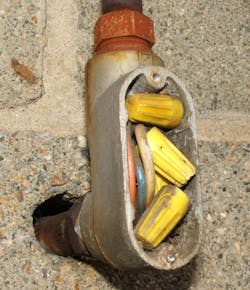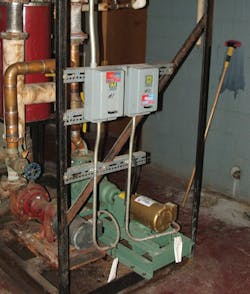How well do you know the Code? Think you can spot violations the original installer either ignored or couldn’t identify? Here’s your chance to moonlight as an electrical inspector and second-guess someone else’s work from the safety of your living room or office. Can you identify the Code violation(s) in this photo? Note: Submitted comments must include specific references from the 2011 NEC.
Hint: If the shoe fits...
‘Tell Them What They’ve Won...’
Using the 2011 NEC, correctly identify the Code violation(s) in this month’s photo — in 200 words or less — and you could win something to put in your toolbox. E-mail your response, including your name and mailing address, to [email protected], and Russ will select three winners (excluding manufacturers and prior winners) at random from the correct submissions. Note that submissions without an address will not be eligible to win. Winners will receive a fluorescent lighting tester from Milwaukee Tool, valued at $199. The product allows complete lamp, ballast, and pin testing, before or after install, without dismantling fixtures.
(Please allow six to eight weeks for delivery of tools.)
AUGUST WINNERS
Our winners this month include: Myron Brubaker, a self-employed electrician from Selinsgrove, Pa.; Mark Mortenson, owner of Mortenson Electrical Contracting in Lake Shore, Minn.; and Frank Velasco, an estimator with Delta Wye Electric, Inc. in Anaheim, Calif. They all correctly identified the missing disconnecting means in this particular equipment arrangement.
Exception No. 1 does not apply here, because the equipment is not more than 600V. Exception No. 2 does not apply either, because these are not coordinated controllers for a single machine. Lastly, Exception No. 3 does not apply, because these are not valve-actuated motor assemblies.
In accordance with 430.102(B), the controller disconnecting means could also be permitted to serve as the disconnecting means for the motor if it is in sight from the motor and the driven machinery. However, there were no disconnects located in sight from this location.






